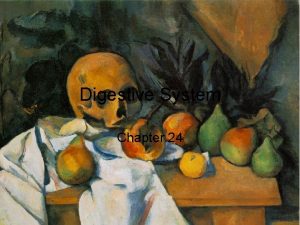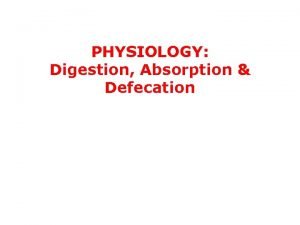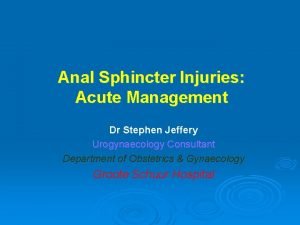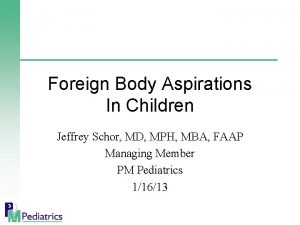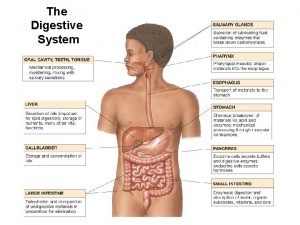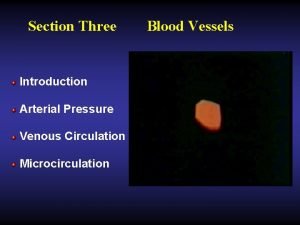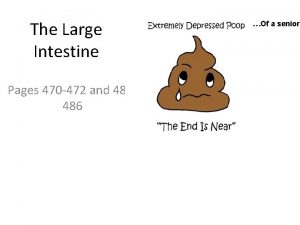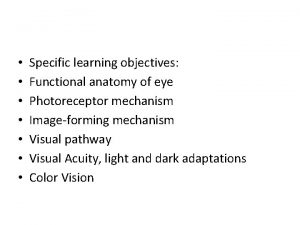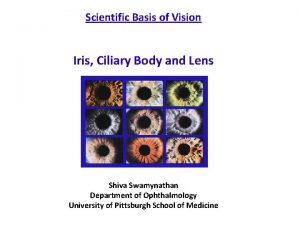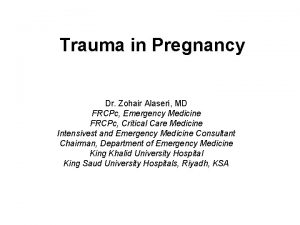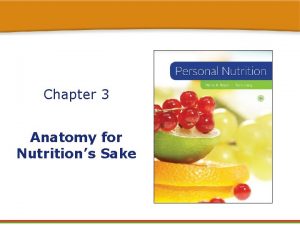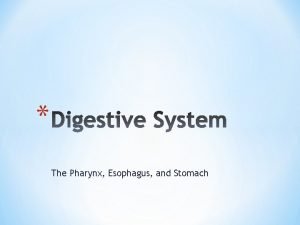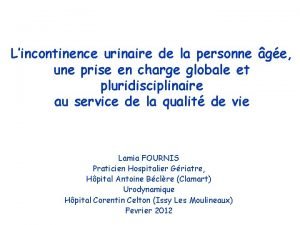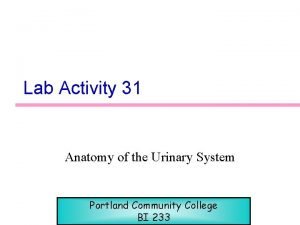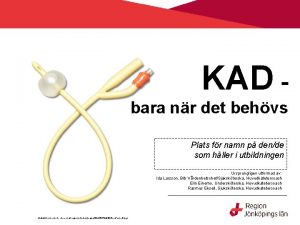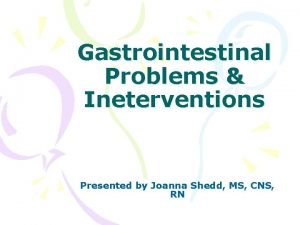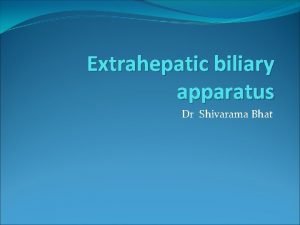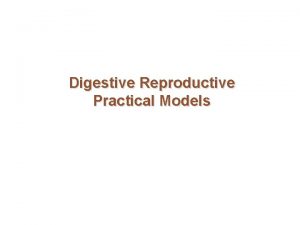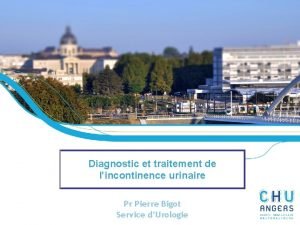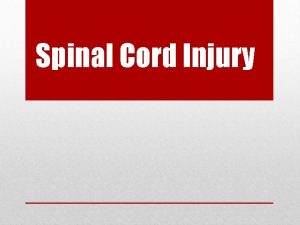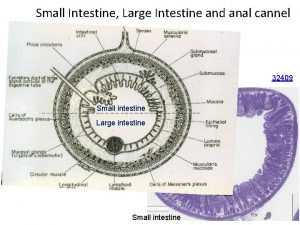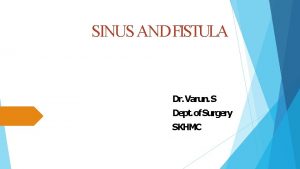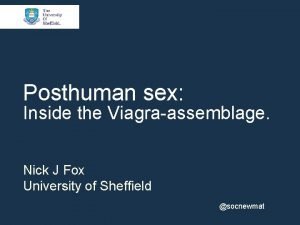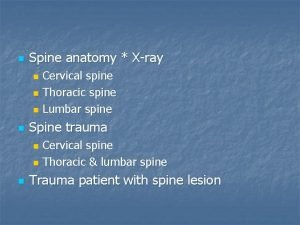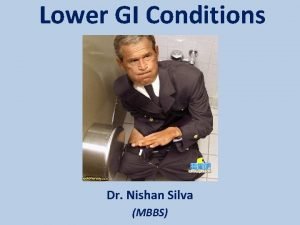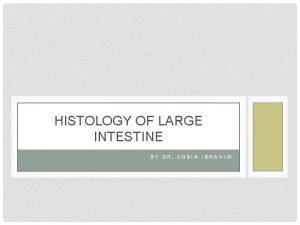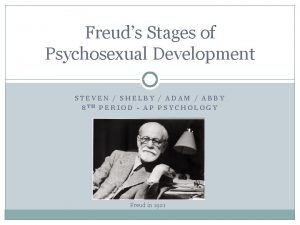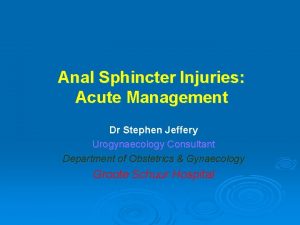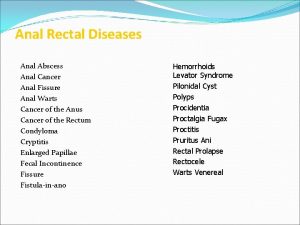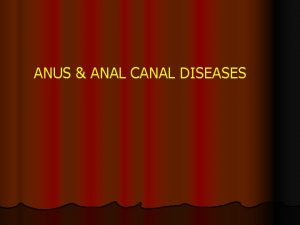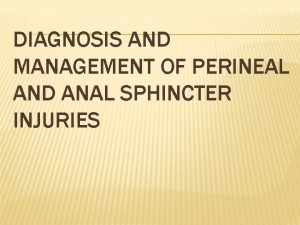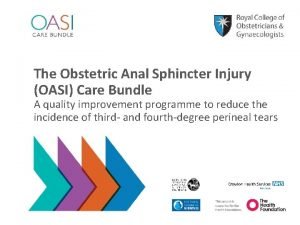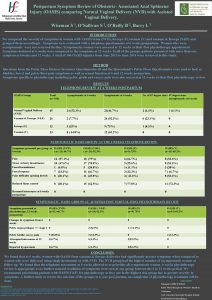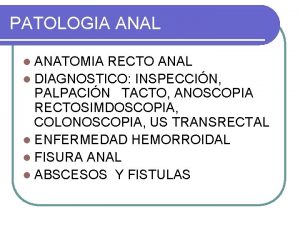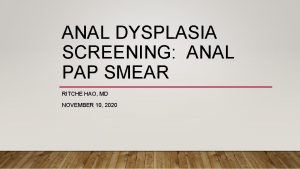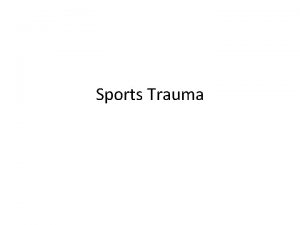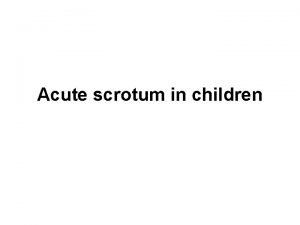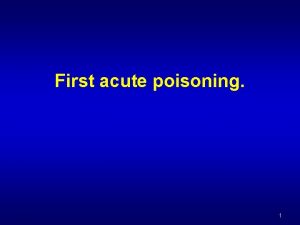Anal Sphincter Injuries Acute Management Dr Stephen Jeffery



















































- Slides: 51

Anal Sphincter Injuries: Acute Management Dr Stephen Jeffery Urogynaecology Consultant Department of Obstetrics & Gynaecology Groote Schuur Hospital

Colorectal Surgeons Gynaecologists

Gynaecologists Colorectal Surgeons


Audit Ø Do you routinely perform an epiotomy when doing an instrumental delivery? l Yes 5 (27%) l No 13 (73%)

Audit Ø Who supervised your first episiotomy repair? l Midwife 10 (55%) l MO 2 (11%) l Registrar 5 (27%) l Consultant 1 (6%)

Audit Ø Who supervised your first third degree tear repair? l Midwife 1 (6%) l MO 1 (6%) l Registrar 14 (77%) l Consultant 2 (11%)

Audit Ø Classification l 3 A & 3 B l 3 A, 3 B, 3 C, 3 D l Don’t know 5 6 3 3 (28%) (33%) (17%)

Background • Diagnosed clinically at time of delivery in 0. 6 -9% of cases • Two-thirds of registrars and consultants in the UK have expressed a “ lack of” or “unsatisfactory” training in the management of OASI. Adams et al Guideline No. 29 London, UK: RCOG; 200 I Fernando et al. BMC Health Services Research. 2002, 2: 9

Most common causes of complaint and litigation arising in labour ward practice Fetal death or injury as a consequence of: o Mismanagement of labour o Failure to recognise CTG abnormalities and act on them o Mismanagement of operative vaginal delivery or shoulder dystocia Maternal injury as a consequence of o Failure to recognise injury to the anal sphincter and repair it o Rupture of the uterus Clements RV. Risk Management and Litigation in Obstetrics and Gynaecology 2001 p 240

Most common causes of complaint and litigation arising in labour ward practice Fetal death or injury as a consequence of: o Mismanagement of labour o Failure to recognise CTG abnormalities and act on them o Mismanagement of operative vaginal delivery or shoulder dystocia Maternal injury as a consequence of o Failure to recognise injury to the anal sphincter and repair it o Rupture of the uterus Clements RV. Risk Management and Litigation in Obstetrics and Gynaecology 2001 p 240

Nomenclature Every obstetric text in RCOG library (Sultan and Thakar) o o 17% no mention of classification 22% classified anal sphincter injury as second degree BMC Health Services Research (2002) o o 672 practicing Consultant obstetricians 33% classified Complete or Partial external sphincter tear as “Second Degree”

Classification of Perineal Lacerations Ø First Degree Laceration of the vaginal epithelium or perineal skin only l Ø Second Degree l Involvement of the vaginal epithelium, perineal skin and muscles but not the anal sphincter

Classification of Perineal Lacerations Ø Third degree l Disruption of the vaginal epithelium, perineal skin, perineal body & internal anal sphincter (IAS) &/or external anal sphincter (EAS) 3 a: <50% EAS torn 3 b: >50% EAS torn 3 c: IAS torn l

Classification of Perineal Lacerations Ø Fourth Degree l l Extension into the rectal mucosa Rectal mucosal tear (buttonhole) without the involvement of the anal sphincter is rare & not included in this classification

Risk Factors for Sphincter Injury Ø Forceps Ø Primiparity Ø Large fetus (>4 kg) Ø Shoulder dystocia Ø Persistant OP position

Risk Factors for Sphincter Injury

Risk Factors for Sphincter Injury N= 5044 SVD 4. 2% sphincter defect Univariate analysis low parity prolonged 1 st and 2 nd stage high birth weight episiotomy forceps Hudelist et al. Am J Obstet Gynecol 2005; 192(3): 875 -81

Risk Factors for Sphincter Injury N= 5044 SVD 4. 2% sphincter defect Univariate analysis low parity prolonged 1 st and 2 nd stage high birth weight episiotomy forceps Multivariate analysis Hudelist et al. Am J Obstet Gynecol 2005; 192(3): 875 -81

Risk Factors for Sphincter Injury Occipitoposterior Position n = 393 Occipitoanterior – OASI 22% Occipitoposterior – OASI 46% Odds ratio – 2. 5 (1. 4 – 4. 7) Logistic Regression Analysis BMI race nulliparity second stage length episiotomy Birth weight HC OP four X higher chance of sphincter injury Wu JM etal. Am J Obstet Gynecol 2005, 193(2): 525 -528

Recognition of Obstetric Anal Sphincter Injury (OASI) All Vaginal deliveries o Systematic examination of perineum and vagina to assess severity of trauma o Rectal examination if episiotomy or any tear Instrumental Delivery or Extensive Perineal Injury (esp those that extend to anal verge) o Examined by an experienced obstetrician trained in the recognition and management of perineal tears RCOG guidelines July 2001

Technique of anal sphincter closure 1. End-to-end 2. Overlap

Technique of repair OASI Considerable variation in management Coloproctologist Obstetric Consultants Trainees End to end 11. 1% 47% 35% Overlap 88% Don’t know 50% 55% 2. 1% 8. 8% Fernando et al. BMC Health Services Research. 2002, 2: 9

Technique of repair OASI Up to 1964 – 5 studies (n= 2000) no faecal incontinence!!!! Sultan and Thakar (2002) o 20 studies since 1982 o 37% (15 -59%) mean prevalence of incontinence following primary repair Sultan AH, Thakar R. Bailiere’s Best Pract Res Clin Obstet Gynecol; 2002: 16, 99 -116

Technique of repair OASI Up to 1964 – 5 studies (n= 2000) no faecal incontinence!!!! Sultan and Thakar (2002) o 20 studies since 1982 o 37% (15 -59%) mean prevalence of incontinence following primary repair Sultan AH, Thakar R. Bailiere’s Best Pract Res Clin Obstet Gynecol; 2002: 16, 99 -116

Technique of repair OASI Overlap Technique o Favoured by colorectal surgeons o 21 Prospective Studies o Secondary repair 74 -100% success o Poorer 5 year outcomes – of about 50% Jorge and Wexner. Dis Colon Rectum 1993; 36: 77 -97

Technique of repair OASI Overlap Technique for Primary Repair o Pilot study (matched controls) o Described additional repair of IAS o Reduction in incontinence from 41% to 8% o Possibly operator influence? ? ? Sultan et al. Br J Obstet Gynaecol 1999; 106: 318 -323

Technique of repair OASI Overlap Technique for Primary Repair o RCT (Fitzpatrick et al) o 112 primiparas o No difference between groups o No separate IAS repair Fitzpatrick et al. Am J Obstet Gynecol 2000; 183: 1220 -1224.

Technique of repair OASI: Which Method? Fernando et al. o RCT , n=64, 1 year follow up o Only 3 b, 3 c, 4 th degree tears End-to-end Overlap Faecal Incontinence Faecal Urgency Dyspareunia 24% 32% Equal 0 p=0. 009 3. 7% p=0. 02 Equal QOL Equal Perineal Pain 20% 0% p=0. 04 Fernando et al. Obstet Gynecol 2006; 107: 1261 -6

Methods of repair for obstetric anal sphincter injury R Fernando, AH Sultan, C Kettle, R Thakar, S Radley Cochrane Database of Systematic Reviews 2006 Issue 3 (Status: New) Copyright © 2006 The Cochrane Collaboration. Published by John Wiley & Sons, Ltd. 1002/14651858. CD 002866. pub 2 This version first published online: 19 July 2006 in Issue 3, 2006 Date of Most Recent Substantive Amendment: 7 April 2006 Objectives To compare the effectiveness of overlap repair versus end-to-end repair following OASIS in reducing subsequent anal incontinence, perineal pain, dyspareunia and improving quality of life.

Main results Three eligible trials, of grade A quality, involving 279 women, were included. There was considerable heterogeneity in the outcome measures, time points and reported results. Meta-analyses showed that there was no statistically significant difference in perineal pain (relative risk (RR) 0. 08, 95% confidence interval (CI) 0. 00 to 1. 45, one trial, 52 women), dyspareunia (RR 0. 62, 95% CI 0. 11 to 3. 39, one trial, 52 women), flatus incontinence (RR 0. 93, 95% CI 0. 26 to 3. 31, one trial, 52 women) and faecal incontinence (RR 0. 07, 95% CI 0. 00 to 1. 21, one trial, 52 women) between the two repair techniques at 12 months but showed a statistically significantly lower incidence in faecal urgency (RR 0. 12, 95% CI 0. 02 to 0. 86, one trial, 52 women) and lower anal incontinence score (weighted mean difference -1. 70, 95% CI -3. 03 to -0. 37) in the overlap group. Overlap technique was also associated with a statistically significant lower risk of deterioration of anal incontinence symptoms over 12 months (RR 0. 26, 95% CI 0. 09 to 0. 79, one trial, 41 women). There was no significant difference in quality of life

Main results Three eligible trials, of grade A quality, involving 279 women, were included. There was considerable heterogeneity in the outcome measures, time points and reported results. Meta-analyses showed that there was no statistically significant difference in perineal pain (relative risk (RR) 0. 08, 95% confidence interval (CI) 0. 00 to 1. 45, one trial, 52 women), dyspareunia (RR 0. 62, 95% CI 0. 11 to 3. 39, one trial, 52 women), flatus incontinence (RR 0. 93, 95% CI 0. 26 to 3. 31, one trial, 52 women) and faecal incontinence (RR 0. 07, 95% CI 0. 00 to 1. 21, one trial, 52 women) between the two repair techniques at 12 months but showed a statistically significantly lower incidence in faecal urgency (RR 0. 12, 95% CI 0. 02 to 0. 86, one trial, 52 women) and lower anal incontinence score (weighted mean difference -1. 70, 95% CI -3. 03 to -0. 37) in the overlap group. Overlap technique was also associated with a statistically significant lower risk of deterioration of anal incontinence symptoms over 12 months (RR 0. 26, 95% CI 0. 09 to 0. 79, one trial, 41 women). There was no significant difference in quality of life

Main results Three eligible trials, of grade A quality, involving 279 women, were included. There was considerable heterogeneity in the outcome measures, time points and reported results. Meta-analyses showed that there was no statistically significant difference in perineal pain (relative risk (RR) 0. 08, 95% confidence interval (CI) 0. 00 to 1. 45, one trial, 52 women), dyspareunia (RR 0. 62, 95% CI 0. 11 to 3. 39, one trial, 52 women), flatus incontinence (RR 0. 93, 95% CI 0. 26 to 3. 31, one trial, 52 women) and faecal incontinence (RR 0. 07, 95% CI 0. 00 to 1. 21, one trial, 52 women) between the two repair techniques at 12 months but showed a statistically significantly lower incidence in faecal urgency (RR 0. 12, 95% CI 0. 02 to 0. 86, one trial, 52 women) and lower anal incontinence score (weighted mean difference -1. 70, 95% CI -3. 03 to -0. 37) in the overlap group. Overlap technique was also associated with a statistically significant lower risk of deterioration of anal incontinence symptoms over 12 months (RR 0. 26, 95% CI 0. 09 to 0. 79, one trial, 41 women). There was no significant difference in quality of life

Main results Three eligible trials, of grade A quality, involving 279 women, were included. There was considerable heterogeneity in the outcome measures, time points and reported results. Meta-analyses showed that there was no statistically significant difference in perineal pain (relative risk (RR) 0. 08, 95% confidence interval (CI) 0. 00 to 1. 45, one trial, 52 women), dyspareunia (RR 0. 62, 95% CI 0. 11 to 3. 39, one trial, 52 women), flatus incontinence (RR 0. 93, 95% CI 0. 26 to 3. 31, one trial, 52 women) and faecal incontinence (RR 0. 07, 95% CI 0. 00 to 1. 21, one trial, 52 women) between the two repair techniques at 12 months but showed a statistically significantly lower incidence in faecal urgency (RR 0. 12, 95% CI 0. 02 to 0. 86, one trial, 52 women) and lower anal incontinence score (weighted mean difference -1. 70, 95% CI -3. 03 to -0. 37) in the overlap group. Overlap technique was also associated with a statistically significant lower risk of deterioration of anal incontinence symptoms over 12 months (RR 0. 26, 95% CI 0. 09 to 0. 79, one trial, 41 women). There was no significant difference in quality of life

Main results Three eligible trials, of grade A quality, involving 279 women, were included. There was considerable heterogeneity in the outcome measures, time points and reported results. Meta-analyses showed that there was no statistically significant difference in perineal pain (relative risk (RR) 0. 08, 95% confidence interval (CI) 0. 00 to 1. 45, one trial, 52 women), dyspareunia (RR 0. 62, 95% CI 0. 11 to 3. 39, one trial, 52 women), flatus incontinence (RR 0. 93, 95% CI 0. 26 to 3. 31, one trial, 52 women) and faecal incontinence (RR 0. 07, 95% CI 0. 00 to 1. 21, one trial, 52 women) between the two repair techniques at 12 months but showed a statistically significantly lower incidence in faecal urgency (RR 0. 12, 95% CI 0. 02 to 0. 86, one trial, 52 women) and lower anal incontinence score (weighted mean difference -1. 70, 95% CI -3. 03 to -0. 37) in the overlap group. Overlap technique was also associated with a statistically significant lower risk of deterioration of anal incontinence symptoms over 12 months (RR 0. 26, 95% CI 0. 09 to 0. 79, one trial, 41 women). There was no significant difference in quality of life

Authors' conclusions The limited data available show that compared to immediate primary end-toend repair of OASIS, early primary overlap repair appears to be associated with lower risks for faecal urgency and anal incontinence symptoms. As the experience of the surgeon is not addressed in the three studies reviewed, it would be inappropriate to recommend one type of repair in favour of another

Technique of repair OASI GUIDELINES (Sultan et al) 1. Performed by an experienced operator 2. Operating theatre 3. GA or Spinal 4. Grade injury 5. Anal epithelium repaired with Vicryl 3/0 or Vicryl rapide 6. Sphincters with 3/0 PDS 7. IAS end to end Andrews, Sultan and Thakar. Reviews in Gynaecological Practice.

Technique of repair OASI: GUIDELINES (Sultan et al) 8. External Sphincter End to End Grasp ends with Allis forceps Figure 8 Andrews, Sultan and Thakar. Reviews in Gynaecological Practice.

End-to-end repair

Technique of repair OASI GUIDELINES (Sultan et al) 8. External Sphincter Overlap Grasp ends with Allis forceps Mobilisation and dissection from ishcio-anal fat laterally Full width of muscle identified Double breast overlap technique Andrews, Sultan and Thakar. Reviews in Gynaecological Practice.

Overlap repair




Technique of repair OASI GUIDELINES (Sultan et al) 9. Rectovaginal exam 10. IV antibiotics 11. Foley catheter – 24 hrs 12. Detailed notes 13. Laxatives 14. EXPLAIN & DEBRIEF Andrews, Sultan and Thakar. Reviews in Gynaecological Practice.

RCT : Diagnosis of anal sphincter tears using U/S N= 752 (not clinically evident sphincter injury) Randomised to scan /no scan With u/s – 5. 6% injury Outcome = faecal incontinence @ 3 /12 - ultrasound group - no ultrasound group @ 1 year - ultrasound group - no ultrasound group 3. 3% 8. 7% (p=0. 002) 3. 2% 6. 7% (p=0. 03) NNT =29 Faltin DL et al. Obstet Gynecol 2005, 106(1): 61 -13

Postnatal Care RCT: Laxatives vs Laxatives + Bulking agents (n=I 47) o Lactulose alone or Lactulose + Fybogel o Similar pain score o Incontinence in immediate post natal period: o o One agent Two agents I 8% 32% p=0. 03 Eogan et al. BJOG 2007; II 4: 736 -740

“The bottom line”

Who Should all acute tears be repaired by colorectal surgeons? Ø Not shown to have better outcomes Ø Fernando et al l 60% had never performed an acute tear 30% had performed <5 in a year Only 19% felt that they should be involved in the acute management of OASI Fernando et al. BMC Health Services Research. 2002, 2: 9

Occult anal sphincter injury and previous repair o Prospective cohort study o 100 women with vaginal delivery of 1 st child o Incontinence of flatus & stool at 3 & 30 months ASD 2 nd delivery Incontinent (%) RR (95% CI) No No Yes 1/129 (3) 1/10(10) 4/25 (16) 5/13 (38) 1 2. 9 4. 6 11. 2 Faltin et al (2001)

Thank you
 Figure 24-2 the wall of the small intestine
Figure 24-2 the wall of the small intestine Bulbocavernosus reflex
Bulbocavernosus reflex Dr stephen jeffery
Dr stephen jeffery Jeffery schor
Jeffery schor Remember lots wife jeffrey r holland
Remember lots wife jeffrey r holland Flaibard
Flaibard Jeffery klaehn
Jeffery klaehn Jeffery ha
Jeffery ha Al shawn jeffery
Al shawn jeffery '
' Av shunt
Av shunt Lower esophageal sphincter is also known as
Lower esophageal sphincter is also known as Ascending large intestine
Ascending large intestine Sphincter pupillae
Sphincter pupillae Iris dilator muscle
Iris dilator muscle Pyloric sphincter histology
Pyloric sphincter histology Fetomaternal hemorrhage
Fetomaternal hemorrhage Rugae
Rugae Boundaries of inguinal canal
Boundaries of inguinal canal Gastroesophageal sphincter
Gastroesophageal sphincter Esophageal sphincter
Esophageal sphincter Ahmad gaber
Ahmad gaber Calendrier mictionnel
Calendrier mictionnel Urethral sphincter
Urethral sphincter Uretrakateter
Uretrakateter Cardiac sphincter
Cardiac sphincter Biliary apparatus
Biliary apparatus Mammary gland lobes
Mammary gland lobes Quelle methode pour arrêter les fuites urinaires la nuit
Quelle methode pour arrêter les fuites urinaires la nuit Iridodialysis
Iridodialysis Nursing diagnosis pancreatitis
Nursing diagnosis pancreatitis Togri ichak
Togri ichak Autonomous vs automatic bladder
Autonomous vs automatic bladder Lamina subglandularis
Lamina subglandularis Congenital sinus example
Congenital sinus example Anal fixation
Anal fixation Anal chancre
Anal chancre Anal sex
Anal sex Alexis quintana
Alexis quintana Oedipus complex which stage
Oedipus complex which stage Anal fixation
Anal fixation Nikki fairchild porn
Nikki fairchild porn Rationalization defense mechanism examples
Rationalization defense mechanism examples Sisman anal sex
Sisman anal sex Source traits examples
Source traits examples Oral stage of development
Oral stage of development Anal personality
Anal personality Chart
Chart Modified dukes staging
Modified dukes staging Intimacy vs isolation
Intimacy vs isolation Anal canal tissue
Anal canal tissue Fixation in oral psychosexual stage
Fixation in oral psychosexual stage
